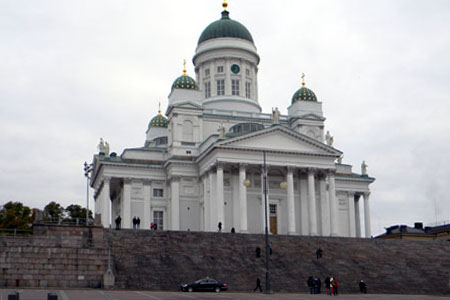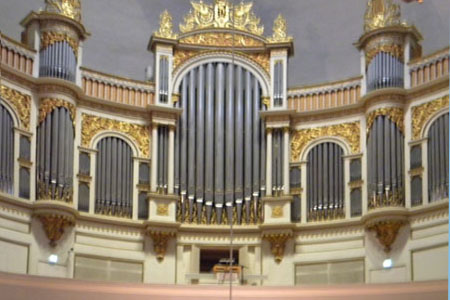| |
 |
 |
 |
| Comment on this report, or find other reports. |
 |
| Our Mystery Worshippers are volunteers who warm church pews for us around the world. If you'd like to become a Mystery Worshipper, start here. |
 |
| Find out how to reproduce this report in your church magazine or website. |
|
|
| 2456: Helsinki
Cathedral, Helsinki, Finland |
 |
 |
 |
Mystery
Worshipper: Paterfamilias.
The church: Helsingin
Tuomiokirkko (Helsinki Cathedral), Helsinki, Finland.
Denomination:
Evangelical Lutheran Church of Finland, Diocese of Helsinki. The Church of Finland is a member of the Lutheran World Federation and the Porvoo Communion.
The building: The
cathedral was designed by architect Carl Ludvig Engel, who also
built the central city square that it dominates. The building
was not completed until 1852, 12 years after Engel's death.
Its large central dome is surrounded by four smaller domes added
later by Ernst Lohrmann, his successor. Notable features are
the large zinc statues on the roof, representing the twelve
apostles, and (inside the church) large statues of Martin Luther,
16th century Reformation theologian Philip Melancthon, and Mikael
Agricola, translator of the Bible into Finnish and regarded
as the founder of the written Finnish language. Even with those
statues, the cruciform-shaped interior is quite sparsely appointed.
The simplified style supposedly reflects Engel's personal view
that Lutheranism should, as a religion, foster internal spiritual
growth, not appreciation of the external. A quite beautiful
painting behind the altar depicting the entombment of Christ
is the only concession to such external stimuli.
The church: This
is both the cathedral church for the Helsinki Lutheran community
and a parish church. It is also a church that plays a larger
role for the Finnish nation, still five years away from celebrating
its 100th anniversary as an independent country. Concerts are
often performed here. Special services are held at the opening
and closing of Parliament and on Independence Day. Prominent
politicians and cultural leaders are often buried from the cathedral
(as, for example, was the famous Finnish composer Jean Sibelius).
The University of Helsinki holds its commencement services here.
The music programme is quite strong, with an exceptional boys
choir. In addition to the weekly Sunday morning eucharist, there
are daily prayer services, occasional Taizé services,
Anglican morning prayer, and holy communion each Wednesday morning.
The neighbourhood: The
cathedral is at the north end of Senate Square, the site of
parades, civic events, New Year's Eve celebrations, and public
demonstrations. Other buildings that face the square are the
Council of State Palace and a main building of the University
of Helsinki. It is in the Helsinki city centre, not far from
the Gulf of Finland harbour, outdoor markets, tree-lined boulevards
with upscale shops and restaurants. It is only a couple of blocks
away from Helsinki's other cathedral, that of the Finnish Orthodox
Church.
The cast: Pr
Mark Saba, church pastor, was celebrant; Pr Suvi-Päivi
Koski, cathedral chaplain, preached; Martti Laitinen played
the organ; and the Helsinki Philharmonic choir sang under the
direction of Dani Juris.
The date & time: Twentieth
Sunday after Pentecost, 14 October 2012, 10.00am.
What was the name of the service?
Messu Helsingin Tuomiokirkossa (Mass at Helsinki Cathedral).
How full was the building?
The cathedral seats 1,300; I estimate that about 300 were present for this service.
Did anyone welcome you personally?
No. The materials we needed to follow the service were available
for pickup on a cart at the church entrance.
Was your pew comfortable?
Gated pews, with no curve in the backs. Padded, but still somewhat
uncomfortable. No kneelers. The congregation largely sat for
the service, save for standing for the gospel and the Sanctus.
How would you describe the pre-service
atmosphere?
Quiet and reverent. The clergy, acolytes and lectors entered
a couple of minutes before the organ prelude, reverenced the
altar and crossed themselves, and then sat down until the service
began.
What were the exact opening words of the
service?
"Isän ja Pojan ja Pyhän Hengen nimeen. Aamen, aamen, aamen." (In the name of the Father, and the Son, and the Holy Spirit. Amen, amen, amen).
What books did the congregation use during the
service?
The hymnal was Virsikirja, a 1986 publication of the Evangelical Lutheran Church in Finland. There was also a seasonal service leaflet, with the order of service and music for all of the sung parts of the liturgy, and a Sunday leaflet, listing the hymns that would be sung, the readings, and the music selections that the choir would be singing.
What musical instruments were played?
A large pipe organ, built by the Danish organ maker Marcussen in 1967. The facade is all that remains of the original instrument installed in 1846 by the German Walcker firm.

Did anything distract you?
There were large sections of spoken Finnish that I did not understand
(especially the sermon and the intercessions). As my eyes wandered
around, it was hard to ignore the austere gaze from Mikael Agricola's
statue, which, according to the Lonely Planet guidebook,
"looks like he's graded your theology exam and taken rather
a dim view of your prospects."
Was the worship stiff-upper-lip, happy clappy, or
what?
The liturgy was formal, but with nothing that could be considered
excessively ceremonial. It was certainly not stuffy. The celebrant
was vested in chasuble, preacher in alb and stole, and much
of the liturgy was chanted. It was an effective blend of classical
Lutheranism and the uniform Western rite. There were three readings,
but I gather the Finnish Church has its own lectionary; it was
definitely not the Revised Common Lectionary in any
of its various manifestations. There were a couple of distinctive
features: a hymn preceded the gospel, with "Alleluias"
following the reading of the gospel. And in the middle of the
intercessions, the spoken prayers stopped, the organ played
quietly, and the preacher lighted a taper from the candles on
the right side of the altar, then went to the left side and
lit a smaller candle there. After the service, this was explained
to me as a way of remembering the faithful departed. We received
communion kneeling at an altar rail.
Exactly how long was the sermon?
14 minutes.
On a scale of 1-10, how good was the preacher?
6 – Very low-key. The chaplain stood in the large pulpit
and read from a prepared text, rarely using her hands for anything
except to turn the pages of her text.
In a nutshell, what was
the sermon about?
Alas ... I know just four words in Finnish. Finland is officially
a bilingual country, but Helsinki is effectively quadri-lingual,
as one regularly sees Finnish, Swedish, English, and Russian
in signage, restaurant menus and the like. However, the cathedral's
worship is exclusively in Finnish. I assume she was preaching
on the gospel reading for the day, John 7:40-52 (the people
say that Jesus is a prophet, but the Pharisees retort that a
prophet does not come out of Galilee).
Which part of the service
was like being in heaven?
As I knelt for communion, the choir were singing Bogoroditse
Devo (Ave Maria/Hail Mary), from Rachmaninoff's Vespers,
Op. 37. Such beautiful music, such beautiful singing (tenors
as comfortable as could be in the upper part of their register,
basses with a rich lower register). All three of the choir's
anthems (sung after the first reading, between the creed and
the intercessions, and at communion) were exquisite. The polyphonic
introit psalm was also chanted in a Russian Orthodox style.
And which part was like being in... er... the other place?
The Finns don't queue, at least not like the British or Americans.
Materfamilias and I had noticed this in other situations as
well, but I was quite surprised as we went to communion that,
well ... in the end it all worked out.
What happened when you hung around after the service looking lost?
Everyone remained in their pews while the organist played a
chorale-prelude by Sweelinck. As soon as the postlude was over,
I approached the woman sitting in front of me and asked about
the candle-lighting bit during the prayers. After she explained
that, we chatted a bit; it turned out that she was not a regular
worshipper there, but lived in the suburbs, and was with a group
of friends visiting the cathedral.
How would you describe the after-service
coffee?
There was none.
How would you feel about making this church your regular (where 10 = ecstatic, 0 = terminal)?
8 – If only it weren't for the language barrier. If I were
ever to live in Finland, I would probably choose to attend Sunday
morning Anglican services at another parish, but keep in touch
with my Lutheran sympathies by coming back to the cathedral
once a month or so. But the liturgy and music were both beautifully
done.
Did the service make you feel glad to be a
Christian?
Absolutely.
What one thing will you remember about all this in seven days' time?
Two things: receiving communion during Rachmaninoff's beautiful anthem, and the candle lighting during the intercessions. |
|
|
 |
 |
 |
| We rely on voluntary donations to stay online. If you're a regular visitor to Ship of Fools, please consider supporting us. |
 |
 |
 |
| The Mystery Pilgrim |
 |
| One of our most seasoned reporters makes the Camino pilgrimage to Santiago de Compostela in Spain. Read here. |
 |
 |
 |
| London churches |
 |
| Read reports from 70 London churches, visited by a small army of Mystery Worshippers on one single Sunday. Read here. |
| |
|
|
|
|


